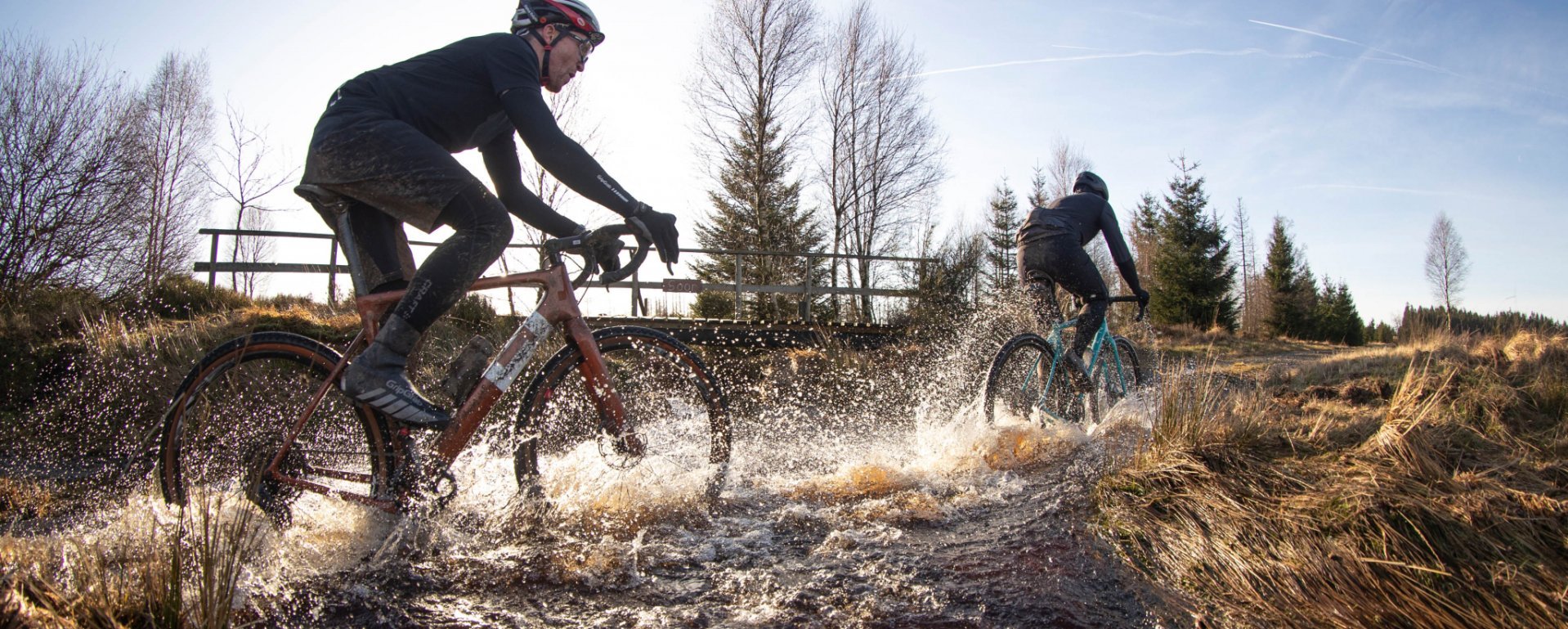
Product test: Thermoformable bike saddles from ...
A bike saddle that adapts to your anatomy? We have tested the thermoformable saddles from REFORM for you, which promise exactly that.
Gravel handlebars are the younger siblings of drop bars, with a stronger focus on comfort, control and view. Read our guide for gravellers.
Gravel handlebars are a variation of classic road bike handlebars. The basic shape is identical, but the design and dimensions differ considerably. It is exactly these small distinctions that make gravel bars either fit perfectly or result in a lazy compromise. Therefore, a little "theory" and preliminary consideration is worthwhile before you decide on the right set of gravel bars.
Classic road cycling is all about speed. Aerodynamics is a major key to success and road handlebars are designed to put the rider in the most streamlined position possible. All dimensions that make the handlebars a little more comfortable while conforming to this "aero dictate". That's why road handlebars are narrow and protrude far forward, and the lower handlebar sinks down even furthered. In any case, it doesn’t abide by pure road bike lore.
With gravel bikes, you leave behind the asphalt road, the high speed of a peloton and often the safety of a closed race track. Your bike and handlebars must optimally fulfil other aspects than just speed and aerodynamics: in addition to low wind resistance, comfort, control and view (in traffic or in nature) become more important. The form of gravel bars takes this into account.
In order to be able to choose your new handlebars perfectly, you should know the dimensions of the handlebars you are currently using. Take this opportunity to determine the dimensions of your stem.
Because the mix of aerodynamics, control, comfort and view can produce very different results, handlebars qualifying as "gravel" vary greatly. Your choice of handlebars starts with body ergonomics: What is your size and build? The taller, wider and heavier you are, the wider your handlebars will be. The rule of thumb for classic road handlebars is that they should align the shoulder, elbow and wrist joints. Whether you’re gripping the brake levers or the lower bar is irrelevant, because these are in the classic road handlebars on one axis. Not so with most gravel cores.
Most gravel bars are flared in the drops, meaning they are wider towards the bottom. This measurement is called "drop flare," or "flare” for short, and is denoted in angular degrees. The spectrum ranges from a few to over 20 degrees. There are three ideas behind the drop flare: first, there is a lot of reaching into the lower bar when riding off-road. More width means at the same time more lever arm and therefore more control. Every mountain biker knows this. Secondly, when riding actively on the lower bar, the forearms move relatively strongly. Pronounced drop flare prevents painful collisions with the top bar. In addition, more flare provides more distance between the lower bar, hands and knees and thus avoids making contact, especially when you’re riding slowly and at corresponding steering angles.
To achieve the ideal gravel handlebar width, you have three possible reference points: Upper bar width, width at the height of the brake lever and the lower bar width. Our tip: As a rule of thumb, the handlebars should correspond to shoulder width at your preferred grip position, and be more or less flared at the bottom depending on the area of use. If you're essentially riding at high speeds on bad roads or gravel tracks, hold back on the drop flare. If you ride your gravel bike more off-road and on single trails, a larger flare will help you.
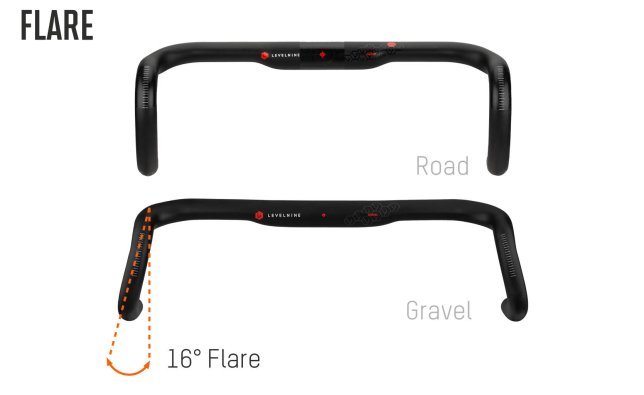
Reach measures how far the handlebar horn extends forward from the top bar, and thus determines the position of the brake lever. The greater the reach of the handlebars, the more stretched your posture on the bike. Of course, there is also the stem width to consider: A large reach can be ergonomically compensated with a shorter stem; of course, it also works the other way around. Gravel bars generally have a shorter reach than tempo-oriented road handlebars. Tip: Our filters allow you to search specifically for your desired reach.
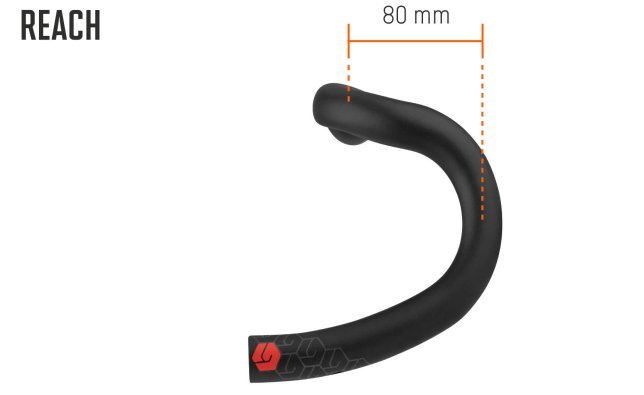
The difference in height between the upper and lower bar is called the drop. The classic road bike is all about speed, resulting in a big drop that lets road cyclists crouch lower. This is less important on a gravel bike, so the drop is usually not as low, and also when riding off-road on the lower bar with one or two fingers on the brake lever. A drop that is too high makes it difficult for you to control the brakes, which is very important. In addition, a riding position with a low drop makes it difficult to see the ideal line and reduces your mobility on the bike. Whether you can easily and comfortably ride with a drop, however, also depends on which grip position you declare to be the zero line. In slang terms: Is the handlebar mounted so high that you go from the ideal height to being "in the basement,” or do you have the handlebar mounted so low that you go from the drop to being in "in the attic” (the upper handlebar)? Our tip: The more you ride off-road, the more the grip in the lower handlebar should be standard and the drop should rather be shorter. The drop is also related to your torso and arm length: the longer you are, the more drop you can comfortably ride with.
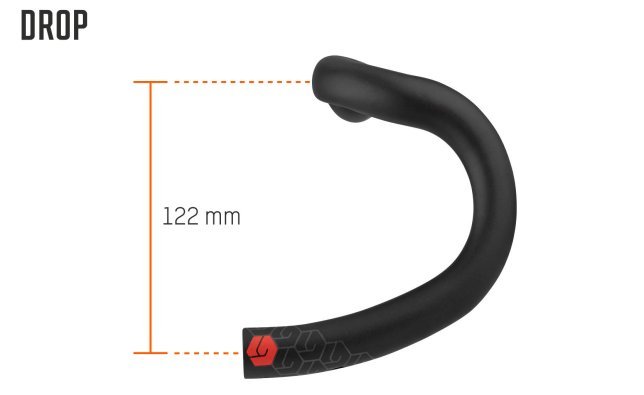
The backsweep describes the bending of the transvere bar to the rear, i.e. in the direction of the rider. Many drivers find this back bend more comfortable when gripping the top bar compared to the straight top bar. At the same time, this is a "trick" in the entire handlebar design: because the reach of the handlebars is shortened without changing the shape and dimensions of the horn arch. Completely logical: the backsweep is also in proportion to the stem length. The larger the backsweep, the longer the stem needs to be to keep the brake levers in the same position.
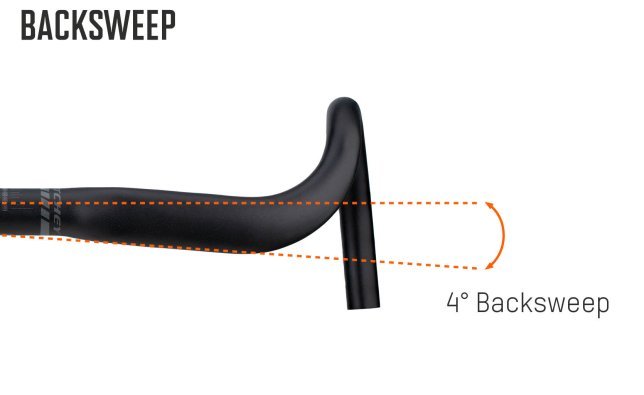
Sticking with the "floors" analogy, some gravel bars, like those in the Hover series from Specialized or the ErgoMax models from Ritchey, have something extra going for them. Their top bars feature a rise, as with MTB handlebars, which lift next to the stem clamp. Think of this as a "third bullet" that increases the top grip without affecting the shape of the drop. Logically, there is a relationship with the stem height, since the rise adds to the stem height. The highest rise (30 mm) belongs to the Truck Stop handlebars from Surly. They basically have MTB dimensions!
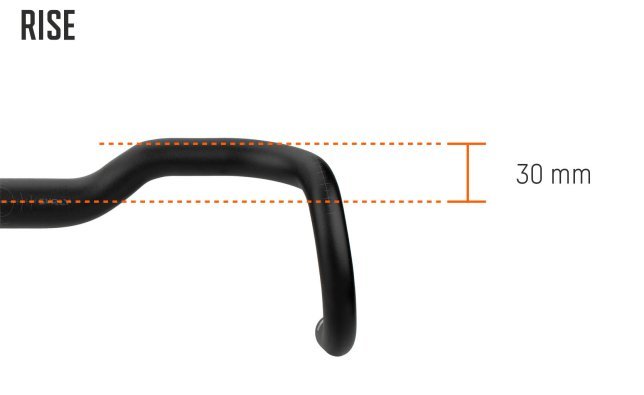
As early as the 1980s, the first road handlebars appeared with horns that had an ergonomic bend instead of a uniform radius. With gravel bars, this shape is of particular importance, as the handlebars are held in this area as soon as the terrain becomes more demanding or the rider picks up speed. "Form fit" is the ergonomic keyword that counts here: The more contact surface there is between hands and handlebars, the more comfortable they are to grip and the better your control when riding wildly. A double-S shape in the kink, such as those on VentureMax handlebars (found here in the carbon version) from Ritchey, has proven to be particularly comfortable for many riders.
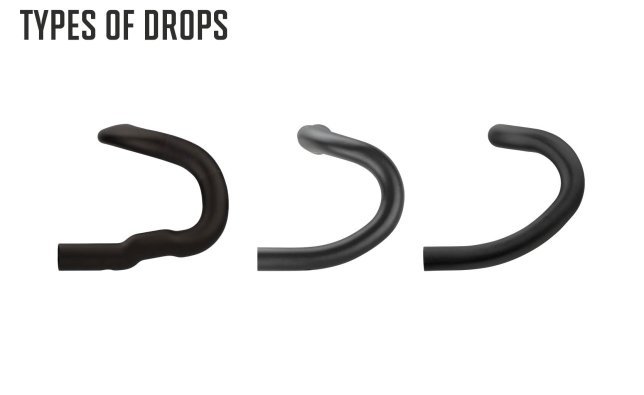
In order for a gravel handlebar to successfully maintain a balancing act between ergonomic design and the dynamic functionality, the bar ends are also bent outwards. “Flare out” is the name of this measurement, and is denoted in angular degrees. These flared bar ends (such as on the Service Course SL-70 XPLR handlebars from Zipp) ensure that your knees and handlebars don't collide early on when you turn in. Also, many riders find a flare out comfortable, similar to backsweep on mountain bike handlebars.
If you want to take your gravel bike on a bikepacking tour, transporting luggage becomes an issue when choosing handlebars. A wide handlebar can accommodate a wider handlebar bag. Drop flare also increases the "storage space" between the handlebars, provided the bag does not sit directly under the top bar. However, a large flare out can lead to collisions between brake levers, or the shifting or braking hands, and the bag. In any case, you should evaluate how you want the handlebar and bag to fit together before your first tour. Note that brake- and shift cables or -housing may collide with the bag when turning, then they must be replaced with longer ones.
Sometimes exotic handlebar models are used on gravel bikes. The RM-016 from Nitto only has a 50 mm drop and at most a high degree flare drop, so you can hardly call it a drop bar anymore, but rather a "dropped Mustache". The Discover Carbon 31.8 from Pro claims to have room for top bar brake levers like those from the GRX series from Shimano.
There is one thing all gravel bars agree on: clamps should measure 31.8 mm. It is also worth paying attention to the clamp width of the handlebars, for example if you want to mount a time trial attachment or various devices (GPS, battery light, etc.). For example, gravel bars from Salsa feature an exceptionally wide clamp. Conversely, an aerodynamic oval-designed top bar considerably reduces the scope for such attachments.
As mentioned several times, there are interactions between the dimensions of the gravel bars and the stem used. That's why you should see them as a unit: The perfect gravel handlebar is nothing if the dimensions of the stem put it in the wrong position. So the measurements must match.
Some gravel bars have recesses for bowden cables and lines, so they don’t hang as high and provide a more comfortable grip. There are also handlebars, such as the Service Course 70 XPLR from Zipp, which are compatible with the electric distributor EW-RS910 for Shimano's Di2. For gravel bikes, it's also worth using extra thick handlebar tape, like the DSP 3.2 from Lizard Skins, or even a double layer: Particularly on long distances, old hands with big hands like to wrap two layers of handlebar tape.
Whether you choose gravel bars made of aluminium or carbon is more than a question of weight, although it is clear that the lightest handlebars are made of carbon. The load-specific design of carbon handlebars generally allows them to be stiff for sprints and steering precision while flexible on rough surfaces. This pays off in greater comfort and prevents premature fatigue due to vibrations. For those who go on adventure tours with various bags and attachments, aluminium is the more robust choice.
No matter which material you choose: Make sure you use a good tool to avoid stripping the screws, and be sure to follow the manufacturer's torque specifications. If in doubt, a torque wrench will help. Grease or carbon assembly paste in the right place should also not be forgotten.
The angle of the handlebars and the mounting point of the brake levers in the bend play an important role in gravle handlebars. In contrast to a road bike, the straight bars of the handlebar horn are not aligned horizontally to the ground, but are adjusted so that they can be gripped comfortably. The position of the brake levers is usually higher on a gravel bike than on a traditional road bike. It is important that the hoods are positioned comfortably when you reach there. At the same time, you need to be able to reach the brake levers easily when riding on the drops. Many manufacturers have markings on the handlebar bend. This simplifies systematic adjustment and the even alignment of both sides.
